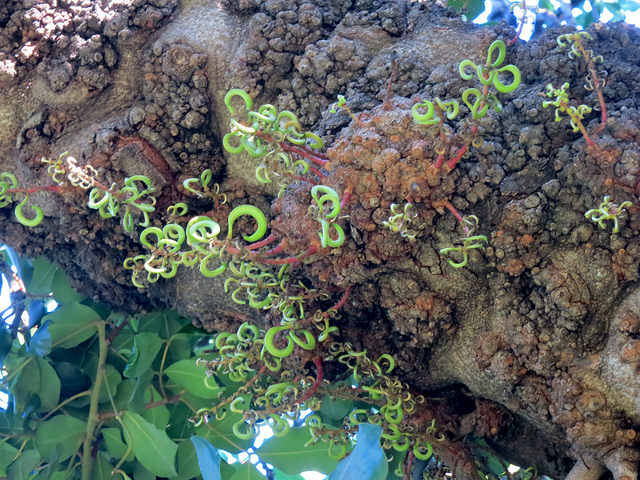by Megan Lynch
At this time of year chocolate is imbibed as hot cocoa, eaten as a confection pressed into the shape of Santa or snowmen, and baked into a variety of holiday treats from recipes often passed down within the family.
Where does this leave you if you have an allergy or sensitivity to chocolate? Feeling a bit left out. There’s no real substitute for the flavor and mouthfeel of chocolate, but something with a similar flavor profile is carob. They both have coffee-esque notes but unlike chocolate, carob is sweet right off the tree and not very bitter. Like chocolate, carob can be used to make hot drinks, baked goods, and confections so it has been seen as “the next best thing” since health food specialty stores started taking off in the mid-20th century.
Carob has such a long history as a cultivated plant that there’s still argument as to precisely where it originated. Regardless, it has a deep history in Eurasia, Mediterranean Europe and Africa. It is now also grown in other areas with a Mediterranean climate such as California, Australia, and South Africa. The pods can be eaten straight off the tree when ripe. The sugary flesh has a caramel-like taste to it. The varieties that have been selected over the centuries have ~ 50% sugar content. Carob also contains protein, calcium, phosphorus, and fibre.
Like cacao, carob is cauliflorous – it bears flowers directly from its trunk (also from its branches, a trait called ramiflory). They’re dioecious although ~1% of carobs have perfect flowers. It has a bushy form that can be trained to grow as a beautiful hardwood tree of about 10m height.
It is very drought-tolerant in order to cope with the Mediterranean climate. Yet it provides beautiful broadleaf shade that is much appreciated in semi-arid areas where it is grown. It can take temperatures over 40C and still give a good crop. It can also take temperatures down around 0C and bounce back. When grown in its proper climate, it lives for centuries and when it’s reached the end of its life, it can be used for its beautiful reddish hardwood.
Carob pods are eaten fresh, or kibbled to extract the seeds and the pods are then ground to powder that is sold either raw or roasted. The raw powder is milder and the roasting brings out some of the coffee- or chocolate-like notes in the flavor. This powder can be used exactly the same way you use cocoa in baking or in making hot cocoa. The pods or kibble can also be steeped in water for a long time and then boiled down. This is done to create a product that is called “carob molasses” in English. It is used in a number of Mediterranean cuisines. Greeks & Cypriots make a nut candy called pastelaki. There are many variations and some of those variations make it with carob molasses. Carob molasses is also my preferred way of making hot carob milk because it dissolves so much more easily than carob powder.
Another way to warm your cockles for the holidays is by making a rum infused with carob. The resulting product has notes of caramel and vanilla and is just the thing for a cold evening. It’s so simple to make, I hesitate to call this a recipe.
People in non-Mediterranean cultures are more familiar with seeing carob in health store bulk food bins as carob-covered raisins or nuts. That carob has added sugar and hydrogenated fats that attempt to make it more of a chocolate substitute but really bury the actual carob flavor. No wonder people are so disappointed with carob if that’s their only exposure to it! No-sugar-added carob is available as carob chips, carob bars, and covering raisins or nuts so I recommend giving that a try. Don’t expect it to taste like chocolate – it doesn’t. But it tastes like carob and that’s quite good enough in my book. I like both carob and chocolate.
Many people have been ingesting carob all along without knowing it. Carob seeds are full of polysaccharides called galactomannans that are prized as a vegetarian alternative to gelatine. As a result, you’ll find “locust bean gum” “carob bean gum” and “tragasol” (all different names for the same thing) as thickeners in yogurt, ice cream, pudding, and other products. So whether it’s ice cream, cake, or candy, enjoy your carob and have a happy holiday!
Further references on carob:
Morton, J. 1987. Carob. p. 65–69. In: Fruits of warm climates. Julia F. Morton, Miami, FL.
Battle, I. and J. Tous 1997. Carob Tree, Ceratonia siliqua L. IPGRI
All photos by Megan Lynch







Pingback: Advent Botany 2016 – Day 15: Carob Santa Is On the Way! — Culham Research Group « Herbology Manchester